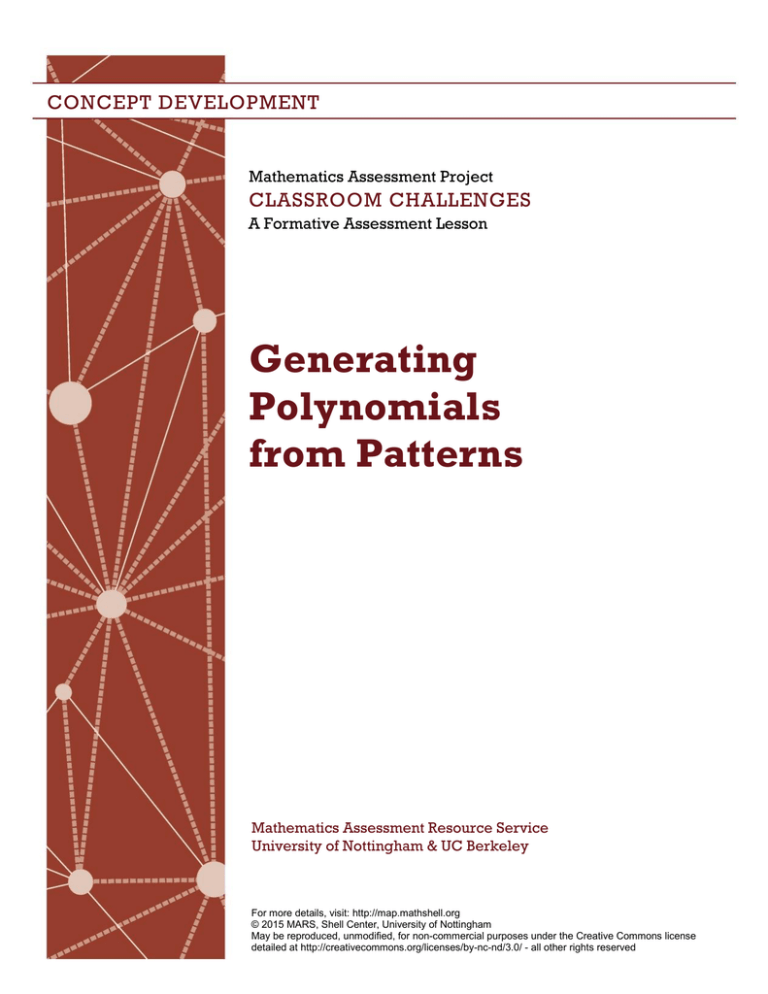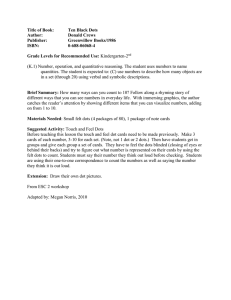
CONCEPT DEVELOPMENT
Mathematics Assessment Project
CLASSROOM CHALLENGES
A Formative Assessment Lesson
Generating
Polynomials
from Patterns
Mathematics Assessment Resource Service
University of Nottingham & UC Berkeley
For more details, visit: http://map.mathshell.org
© 2015 MARS, Shell Center, University of Nottingham
May be reproduced, unmodified, for non-commercial purposes under the Creative Commons license
detailed at http://creativecommons.org/licenses/by-nc-nd/3.0/ - all other rights reserved
Generating Polynomials from Patterns
MATHEMATICAL GOALS
This lesson unit is intended to help you assess how well students are able to manipulate and calculate
with polynomials. In particular, it aims to identify and help students who have difficulties in:
• Switching between visual and algebraic representations of polynomial expressions.
• Performing arithmetic operations on algebraic representations of polynomials, factorizing and
expanding appropriately when it helps to make the operations easier.
COMMON CORE STATE STANDARDS
This lesson relates to the following Standards for Mathematical Content in the Common Core State
Standards for Mathematics:
A-APR: Perform arithmetic operations on polynomials.
A-SSE: Interpret the structure of expressions.
This lesson also relates to all the Standards for Mathematical Practice in the Common Core State
Standards for Mathematics, with a particular emphasis on Practices 1, 2, 7, and 8:
1. Make sense of problems and persevere in solving them.
2. Reason abstractly and quantitatively.
3. Construct viable arguments and critique the reasoning of others.
4. Model with mathematics.
5. Use appropriate tools strategically.
6. Attend to precision.
7. Look for and make use of structure.
8. Look for and express regularity in repeated reasoning.
INTRODUCTION
In this lesson students make connections between representations, clear parentheses, simplify,
factorize, and use the arithmetic of polynomials in a purposive context.
• Before the lesson students work individually on the Sequences and Equations task. You review
their responses and create questions for students to consider, to help improve their work.
• You introduce the lesson by showing students how the card matching activity works. Students
then work collaboratively in small groups to match diagrammatic and algebraic representations of
polynomials, displaying their work on posters. Students share their finished posters, comparing
reasoning and checking that explanations are clear and complete.
• In a whole-class discussion, you reflect on the strategies students have used to complete the task.
• In a follow-up lesson students work individually to review their solutions to the initial assessment
task before completing a second task, Sequences and Equations (revisited).
MATERIALS REQUIRED
•
•
•
Each student will need a copy of Sequences and Equations and Sequences and Equations
(revisited), a mini-whiteboard, pen, and eraser.
Each small group of students will need the cut-up card sets Sequences of Dots and Adding
Polynomials, a large sheet of poster paper, a glue stick, and a pencil.
Students needing an extension should be given Card Set: Blank Cards to create their own
sequences of dots with algebraic expressions.
TIME NEEDED
Approximately 15 minutes before the lesson, a 75-minute lesson (or two 40-minute lessons), and 15
minutes in a follow-up lesson. Exact timings with depend on the needs of your class.
Teacher guide
Generating Polynomials from Patterns
T-1
BEFORE THE LESSON
Assessment task: Sequences and Equations (15 minutes)
Have the students do this task, in class or for
Sequences and Equations
homework, a day or more before the lesson.
1.
These dot diagrams show the beginning of a sequence of patterns:
This will give you an opportunity to assess the
n=1
n=2
n=3
n=4
work and to find out the kinds of difficulties
students have with it. You should then be able
to target your help more effectively in the
subsequent lesson.
(a) Draw the fifth pattern in the sequence in the space above.
Manipulating Polynomials
Student Materials
Alpha Version January 2012
n=5
(b) How many dots of each color will there be in the 10th pattern? White: !!!.. Black: !!!!.
Give each student a copy of Sequences and
Equations. Introduce the task briefly and
explain the purpose of the task:
(c) The number of black dots in the nth diagram is given by the expression: n +1.
Write algebraic expressions for the number of white dots and for the total number of dots:
Number of
white dots
Number of
black dots
!!!!!!!!!
This task is about sequences of patterns
and algebraic expressions and shows how
you can use diagrams to help understand
the algebra.
Do not worry if you cannot answer all the
questions. Next lesson we will work on a
task that should help you progress on this
topic.
Spend 15 minutes, working alone,
answering the questions.
2.
+
Total
! number of dots
=
n +1
!!!!!!!!!
These dot diagrams show the beginning of another sequence of patterns:
n=1
!
n=2
n=3
n=4
(a) Complete the equation below with algebraic expressions for the number of white dots, number of
black dots, and total number of dots:
Number of
white dots
!!!!!!!!!
Number of
black dots
+
!!!!!!!!!
Total
number of dots
=
!!!!!!!!!
(b) Rewrite the expression for the total in its simplest, factorized form if you haven’t done so
already.
It is important that, as far as possible, students
answer the questions without assistance. If students are struggling to get started, ask questions that
help them to understand what they are being asked to do. The first few questions in the Common
issues table on the next page may be helpful.
© 2012 MARS, University of Nottingham
S-1
Assessing students’ responses
Collect students’ responses to the task. Make some notes on what their work reveals about their
current levels of understanding and any difficulties they encountered.
We suggest that you do not score students’ work. The research shows that this will be
counterproductive, as it will encourage students to compare scores and distract their attention from
what they might do to improve their mathematics. Instead, help students to make further progress by
summarizing their difficulties as a list of questions. Some suggestions for these are given in the
Common issues table.
We suggest you make a list of your own questions, based on your students’ work. We recommend
you either:
•
write one or two questions on each student’s work, or
give each student a printed version of your list of questions and highlight the questions for each
individual student.
If you do not have time to do this, you could select a few questions that will be of help to the majority
of students, and write these on the board when you return the work to the students in the follow-up
lesson.
•
Teacher guide
Generating Polynomials from Patterns
T-2
Common issues:
Suggested questions and prompts:
Draws dot diagram incorrectly
For example: The student draws the correct
number of dots, but does not follow the pattern.
Or: The student does not see the pattern at all and
draws a dot diagram containing too many/few
dots.
Relies on counting
For example: The student draws diagrams for n =
6, 7, 8, 9, and 10 and then counts the number of
dots (Q1b.)
Cannot link the dot diagrams to the algebra
For example: The student just counts the dots and
works out the number sequence.
Provides numbers of dots for a specific case
rather than an algebraic expression
For example: The student writes 9 + 16 = 25 as
the solution to Q2a.
Factorization of algebraic expressions is
incorrect or omitted
For example: The student leaves the algebraic
expression for the total number of dots as (n – 1)2
+ 4n or similar (Q2b.)
Completes the task
Teacher guide
• Describe how the dot diagram changes as n
increases. What is happening to the number of
white dots? What is happening to the number
of black dots?
• What stays the same when you move from one
diagram to the next? What changes? In what
way does it change?
• Can you see a pattern in the way the dots are
arranged?
• How could you work out the number of dots in
the 10th pattern without counting them all?
• Is this the most efficient method? How could
you find the number of dots without drawing
diagrams 6,7, 8, and 9?
• How does the algebraic expression ‘n + 1’
connect to the pattern of black dots? Can you
draw on the diagram to show this?
• Which parts of the pattern always contain n
dots?
• You have identified the number of dots in the
4th pattern. How could you describe the
number of dots in terms of n?
• Can you see a pattern in the way the dots are
arranged? What shape are the dots arranged
in?
• How could you combine these two expressions
into one? What do you know about (n – 1)2?
• Look at the dot diagrams as a whole (black
and white dots together). What do you see?
How could you use what you notice to write
an algebraic expression for the total number of
dots?
• Can you find two different algebraic
expressions that add to give 3n or (n + 1)2?
What would the dot diagrams look like for
these expressions?
Generating Polynomials from Patterns
T-3
SUGGESTED LESSON OUTLINE
Introduction: Dot Diagrams (10 minutes)
Introduce the lesson:
At the end of this lesson, I’m going to ask you to review your work on Sequences and Equations.
First, we are going to do some group work on connecting dot diagrams to polynomials.
Check that the class are not confused by the term ‘polynomial’; there is no need to go into great
depth.
Do you remember what a polynomial is? [Linear expressions, quadratics, cubics, but not things
like 1/x or square roots.]
The algebraic expressions 4n, n2 +1 are examples of polynomials.
Give each student a mini-whiteboard, pen, and eraser. Display Slide P-1 of the projector resource:
Dot Diagrams
n=1
n=2
n=3
n=4
Take time to check that students understand the use of dot diagrams to represent a sequence of
patterns.
Describe the pattern you see in the dots.
Projector Resources
P-1
Manipulating Polynomials
Students may well talk about the square pattern of the whole array and ignore the different color dots.
On your whiteboard draw the diagram for n = 5
[
]
Once students have had a chance to draw a diagram for n = 5, display Slide P-2 and discuss any
variations in the diagrams produced. Once students are all agreed on what the diagram looks like,
discuss its features:
What can you tell me about the number of black dots? [e.g. they increase by one each time.]
What can you tell me about the number of white dots? [e.g. they increase by 2, 4, 6, 8, … ]
The pattern for the sequence of white dots is less obvious. Encourage students to look at groups of
dots. For example, the n = 4 diagram has a group of 4 by 3 dots plus 1 dot, the n = 3 diagram has a
group of 3 by 2 dots plus 1 dot, etc. Students may find it helpful to draw around groups of dots.
How many black dots would there be in the nth diagram? [n – 1.]
How many white dots would there be in the nth diagram? [n2 – n + 1. ]
Allow students to explore different ways of visualizing the dot groupings.
For example, some students may describe the white dots with the algebraic expression ‘n(n - 1) + 1’
or ‘(n - 1)2 + n’ or ‘n2 – (n – 1)’.
Teacher guide
Generating Polynomials from Patterns
T-4
Once students have had sufficient time to consider the patterns of white and black dots, reinforce the
idea that the black and white dots add together to give the complete dot diagram. Give students the
opportunity to discuss and complete the table on Slide P-3 of the projector resource. The table may be
completed with, for example, the following algebraic expressions:
Number of
white dots
(n −1)2 + n
Number of
black dots
+
n −1
Total
number of dots
=
n2
Explain to students that during this lesson they are going to be working with some similar diagrams
and tables, as well as manipulating the algebraic expressions to check that the polynomial equations
work.
Collaborative small-group work: matching representations (30 minutes)
Organize students into groups of two or three.
Give each group cut-up copies of Card Set: Sequence of Dots (three sheets) and Card Set: Adding
Polynomials, a large sheet of poster paper, and a glue stick. They will also need a pencil.
Students are to work in their small groups, matching sequences of dot diagrams to tables of algebraic
expressions, generated by adding polynomials.
Introduce the lesson activity:
You are going to use these cards to make a poster that shows the connections between dot
diagrams and algebraic expressions.
Start by choosing a dot diagram card and look for a polynomial card that matches it. You may
need to complete some of the missing information to be able to do this.
See if you can spot patterns in the dot diagrams that match the algebra, rather than counting all
the dots. You may find it helpful to draw around groups of dots.
Explain how students should work together:
Take turns to find a match. When it’s your turn, explain your reasoning clearly.
The others in the group should listen and watch.
If they agree with the reasons given, they should explain again in their own words. If they
disagree, they must explain their reasons. Continue to debate until you have all come to an
agreement.
It may be that the card has been correctly matched but each member of the group describes the
number of white/black dots with a different algebraic expression. Check to see if these
expressions are equivalent.
Once you are happy with the matching, move on to the next card.
These instructions are summarized on Slide P-4 of the projector resource.
The purpose of this structured work is to encourage each student to engage with their partner’s
explanations and to take responsibility for their partner’s understanding. Students should use their
mini-whiteboards to share ideas and explain their thinking to each other.
During small-group work, you have two tasks: to notice students’ approaches and difficulties and to
support them working as a group.
Teacher guide
Generating Polynomials from Patterns
T-5
Notice students’ approaches and difficulties
Observe students as they work together on the task. Are students finding correct matches? Do they
recognize and draw structure in dot diagrams and link this to the algebra? Do they manipulate the
algebraic expressions into different forms by expanding, factorizing, and collecting like terms? Do
students within a group use the same strategies for matching the cards? Are they substituting numbers
into expressions and counting dots? Are they starting with the dot diagrams and writing down the
structures they see, or looking at the algebra first? Do they reveal any common misconceptions, such
as (n + 1)2 = n2 + 1?
You may want to use the questions in the Common issues table to help address misconceptions.
€
Support students working as a group
Support students in working together, encouraging them to take turns. If you notice that only one
partner is matching/completing cards, ask the other student(s) to explain the reasons for the
match/algebraic expressions.
Amy matched these two cards. Linda, why do you think these two cards go together?
If students in the group take different approaches when matching cards, encourage them to clearly
explain the basis for a choice.
Why have you matched these two cards? Can anyone explain this match in a different way?
Can you explain why the number of white/black dots can be represented by this expression? How
else could you explain this?
Try to avoid giving students the information they need to match pairs. Instead, focus on helping them
develop strategies for working, such as leaving cards they cannot match until last and looking for
differences and similarities. Ask them to recall different ways of manipulating algebraic expressions
such as clearing parentheses and factorizing, but do not give them hints about which techniques to
use. Encourage students to divide up the dots in the diagrams in patterned ways, asking them to
explain how to change from one diagram to the next and how the structures match those in the
polynomials.
Can you show the expression for the number of white/black dots on the diagram? How else could
you explain this?
If one group struggles with an element of the task, you could refer them to a group experiencing more
success. If a group struggles for more then five minutes to make any matches, advise them to
concentrate on the dot diagrams. Can they write an algebraic expression for the number of white dots?
Can they write an algebraic expression for the number of black dots? They may find it helpful to draw
the next diagram in the sequence, to focus their attention on the structure of the diagrams.
As groups begin to finalize matches, make sure that they have completed the polynomial cards with
algebraic expressions.
If you are happy with your matches, check that you have completed the algebraic expressions on
the polynomials cards.
You now need to glue down the cards and add an explanation of why these cards match. Include
on your poster any equivalent algebraic expressions you have used to help you to match the
cards.
Make sure you spend some time carefully checking the algebra. You may need to clear
parentheses or factorize as you do this.
Teacher guide
Generating Polynomials from Patterns
T-6
Whilst students work on their posters, observe and support them as before. Some groups may not
manage to match all of the cards and it is not essential that they do so. If students do successfully
complete all of the matches, give them a copy of the Card Set: Blank Cards. Ask them to design two
new cards of their own, which they can then ask someone else in the group to complete. They will
need to draw the dot diagrams for their chosen sequence as well as deciding which algebraic
expressions to include.
Extending the lesson over two days
If you are taking two days to complete the lesson unit then you may want to end the first lesson here.
At the end of the first lesson make sure that all matched cards have been stuck onto posters. Then at
the start of the second day, allow students time to familiarize themselves with their posters before
sharing their work with another group.
Sharing posters (15 minutes)
Once students have finished their posters, get them to share their work.
Now, one person from each group, get up and visit a different group and look carefully at their
poster. Do you understand their explanations? Ask them to explain anything you don’t
understand.
After a few minutes, get students to reverse roles: the visitors should return to their own posters and
their partners should visit another group. It does not matter if students visit a poster that contains
different matched cards to the ones on their poster. The aim of this activity is to give students the
opportunity to critique each other’s explanations.
Whole-class discussion (20 minutes)
Organize a whole-class discussion to explore the different strategies used by students when matching
the cards, as well as identifying areas in which students struggled. It is likely that some groups will
not have matched all of the cards and so the aim of this discussion is to encourage contributions from
everyone in the class, rather than focusing on specific card matches.
Give me a pair of cards that was easy to match. Why was this?
Did anyone find these cards difficult to match or use a different strategy to the one explained?
Encourage students to describe why their expressions and equations match the dot diagram, rather
than merely describing the process of matching the cards.
Why does this expression represent the number of white/black dots? Can you show it on the dot
diagram?
How else could you explain it?
Did anyone write down a different expression for the number of white/black dots?
Students may well assume that an expression is different, when in fact it is the same expression
written in a different form. Encourage students to check their algebra and manipulate their
expressions when comparing their work during this whole-class discussion.
Which expression is the easiest to visualize/explain? Why is this?
How did you check the algebra when completing the polynomial equations?
How could this expression be simplified? Does simplifying make it easier to see the match or
more difficult? Explain why this is.
Ask students what they learned by looking at other students’ work and whether or not this helped
them with dot diagrams that they had found difficult to match or were unsure about:
Teacher guide
Generating Polynomials from Patterns
T-7
Which sequence of dots did you find most difficult to match to a polynomial? Why was this?
Had the group that you visited matched this sequence of dots to a polynomial? In what ways did
their explanation of the match help?
Did anyone disagree with a match that another group had made? Explain why this was.
Try to draw out the strategies students used when matching the cards.
Did you notice any similarities in the cards, which helped you with subsequent matches?
Did you make any assumptions that resulted in incorrect matches? How did you recognize this?
During the discussion, address any issues you have noticed as students worked on the activity,
making specific reference to any misconceptions. You may want to use the questions in the Common
issues table to support this discussion.
Follow-up lesson: reviewing the assessment task (15 minutes)
Give each student a copy of the assessment task Sequences and Equations (revisited), along with their
responses to the assessment task Sequences and Equations with your questions written on them. If
you have not written questions on each script, write your list of questions on the board.
Read through your solutions to Sequences and Equations and the questions (on the board/written
on your script). Answer these questions and revise your response.
Now take a look at the second sheet: Sequences and Equations (revisited). Can you use what you
have learned to answer these questions?
Some teachers give this task for homework.
Teacher guide
Generating Polynomials from Patterns
T-8
SOLUTIONS
Assessment task: Sequences and Equations
1
(a) Diagram for the fifth pattern:
(b) There will be 19 white dots and 11 black dots in the 10th pattern.
(c) Number of white dots = 2n - 1 and total number of dots = 3n.
2
(a) & (b) Number of white dots = (n – 1)2, number of black dots = 4n and total number of dots
in simplest, factorized form = (n + 1)2.
Assessment task: Sequences and Equations (revisited)
1
(a) Diagram for the fifth pattern:
(b) Number of white dots = 3n - 1 and total number of dots = 4n.
2
(a) Number of white dots = 4n, number of black dots = n2 + 4 and total number of dots in
simplest, factorized form = (n + 2)2.
Lesson task:
Teacher guide
Generating Polynomials from Patterns
T-9
Students may well complete the polynomial cards with different, yet equivalent algebraic expressions
to the ones shown above. For example, they may write n + (n – 1) on Card 1 instead of 2n - 1.
When students are making their poster, encourage them to simplify their algebra as part of the
checking process.
Teacher guide
Generating Polynomials from Patterns
T-10
Sequences and Equations
1. These dot diagrams show the beginning of a sequence of patterns:
n=1
n=2
n=3
n=4
n=5
(a) Draw the fifth pattern in the sequence in the space above.
(b) How many dots of each color will there be in the 10th pattern? White: ……….. Black: ………….
(c) The number of black dots in the nth diagram is given by the expression: n +1.
Write algebraic expressions for the number of white dots and for the total number of dots:
Number of
white dots
Number of
black dots
………………………
n +1
+
Total
number of dots
=
………………………
2. These dot diagrams show the beginning of another sequence of patterns:
n=1
n=2
n=3
n=4
(a) Complete the equation below with algebraic expressions for the number of white dots, number of
black dots, and total number of dots:
Number of
white dots
Number of
black dots
………………………
+
………………………
Total
number of dots
=
………………………
(b) Rewrite the expression for the total in its simplest, factorized form, if you haven’t done so
already.
Student materials
Generating Polynomials from Patterns
© 2015 MARS, Shell Center, University of Nottingham
S-1
Card Set: Sequences of Dots
A
n=1
n=2
n=3
n=4
B
n=1
n=2
n=3
n=4
C
n=1
n=2
n=3
n=4
D
n=1
n=2
n=3
n=4
Student materials
Generating Polynomials from Patterns
© 2015 MARS, Shell Center, University of Nottingham
S-2
Card Set: Sequences of Dots (continued 1)
E
n=1
n=2
n=3
n=4
F
n=1
n=2
n=3
n=4
G
n=1
n=2
n=3
n=4
H
n=1
n=2
n=3
n=4
Student materials
Generating Polynomials from Patterns
© 2015 MARS, Shell Center, University of Nottingham
S-3
Card Set: Sequences of Dots (continued 2)
I
n=1
Student materials
n=2
n=3
Generating Polynomials from Patterns
© 2015 MARS, Shell Center, University of Nottingham
n=4
S-4
Card Set: Adding Polynomials
1
White
Black
+
2
White
=
Black
+
3
White
Black
White
5
Black
White
6
Black
White
n(n -1)
7
Black
White
8
White
=
4n
White
=
Total
=
(2n -1)2
Black
+
Student materials
Total
Black
+
9
(n +1)2
Total
Black
+
n 2 +1
Total
=
+
n2
Total
=
+
n(n +1)
Total
=
+
4n
Total
=
+
4
Total
n(n -1)
2
=
Generating Polynomials from Patterns
© 2015 MARS, Shell Center, University of Nottingham
n2
S-5
Card Set: Blank Cards
Now make up two sequences of your own:
n=1
n=2
n=3
n=4
n=1
n=2
n=3
n=4
White
Black
+
White
=
Black
+
Student materials
Total
Total
=
Generating Polynomials from Patterns
© 2015 MARS, Shell Center, University of Nottingham
S-6
Sequences and Equations (revisited)
1. These dot diagrams show the beginning of a sequence of patterns:
n=1
n=2
n=3
n=4
n=5
(a) Draw the fifth pattern in the sequence in the space above.
(b) The number of black dots in the nth diagram is given by the expression: n +1.
Write algebraic expressions for the number of white dots and for the total number of dots:
Number of
white dots
Number of
black dots
………………………
+
n +1
Total
number of dots
=
………………………
2. These dot diagrams show the beginning of another sequence of patterns:
n=1
n=2
n=3
n=4
(a) Complete the equation below with algebraic expressions for the number of white dots, number of
black dots, and total number of dots:
Number of
white dots
Number of
black dots
………………………
+
………………………
Total
number of dots
=
………………………
(b) Rewrite the expression for the total in its simplest, factorized form, if you haven’t done so
already.
Student materials
Generating Polynomials from Patterns
© 2015 MARS, Shell Center, University of Nottingham
S-7
Dot Diagrams
n=1
Projector Resources
n=2
n=3
Generating Polynomials from Patterns
n=4
P-1
Dot Diagrams
n=1
Projector Resources
n=2
n=3
Generating Polynomials from Patterns
n=4
n=5
P-2
Dot Diagrams
n=1
Projector Resources
n=2
n=3
Generating Polynomials from Patterns
n=4
n=5
P-3
Working in Groups
1. Take turns to find a match.
2. When it’s your turn, explain your reasoning clearly.
3. If others in your group agree with your reasoning, they
should explain it again in their own words. If they
disagree, they must explain why they think you are
incorrect.
4. Continue to debate until you have all come to an
agreement.
5. Once you are happy with the matching, move onto the
next card.
Projector Resources
Generating Polynomials from Patterns
P-4
Mathematics Assessment Project
Classroom Challenges
These materials were designed and developed by the
Shell Center Team at the Center for Research in Mathematical Education
University of Nottingham, England:
Malcolm Swan,
Nichola Clarke, Clare Dawson, Sheila Evans, Colin Foster, and Marie Joubert
with
Hugh Burkhardt, Rita Crust, Andy Noyes, and Daniel Pead
We are grateful to the many teachers and students, in the UK and the US,
who took part in the classroom trials that played a critical role in developing these materials
The classroom observation teams in the US were led by
David Foster, Mary Bouck, and Diane Schaefer
This project was conceived and directed for
The Mathematics Assessment Resource Service (MARS) by
Alan Schoenfeld at the University of California, Berkeley, and
Hugh Burkhardt, Daniel Pead, and Malcolm Swan at the University of Nottingham
Thanks also to Mat Crosier, Anne Floyde, Michael Galan, Judith Mills, Nick Orchard, and Alvaro
Villanueva who contributed to the design and production of these materials
This development would not have been possible without the support of
Bill & Melinda Gates Foundation
We are particularly grateful to
Carina Wong, Melissa Chabran, and Jamie McKee
The full collection of Mathematics Assessment Project materials is available from
http://map.mathshell.org
© 2015 MARS, Shell Center, University of Nottingham
This material may be reproduced and distributed, without modification, for non-commercial purposes,
under the Creative Commons License detailed at http://creativecommons.org/licenses/by-nc-nd/3.0/
All other rights reserved.
Please contact map.info@mathshell.org if this license does not meet your needs.





